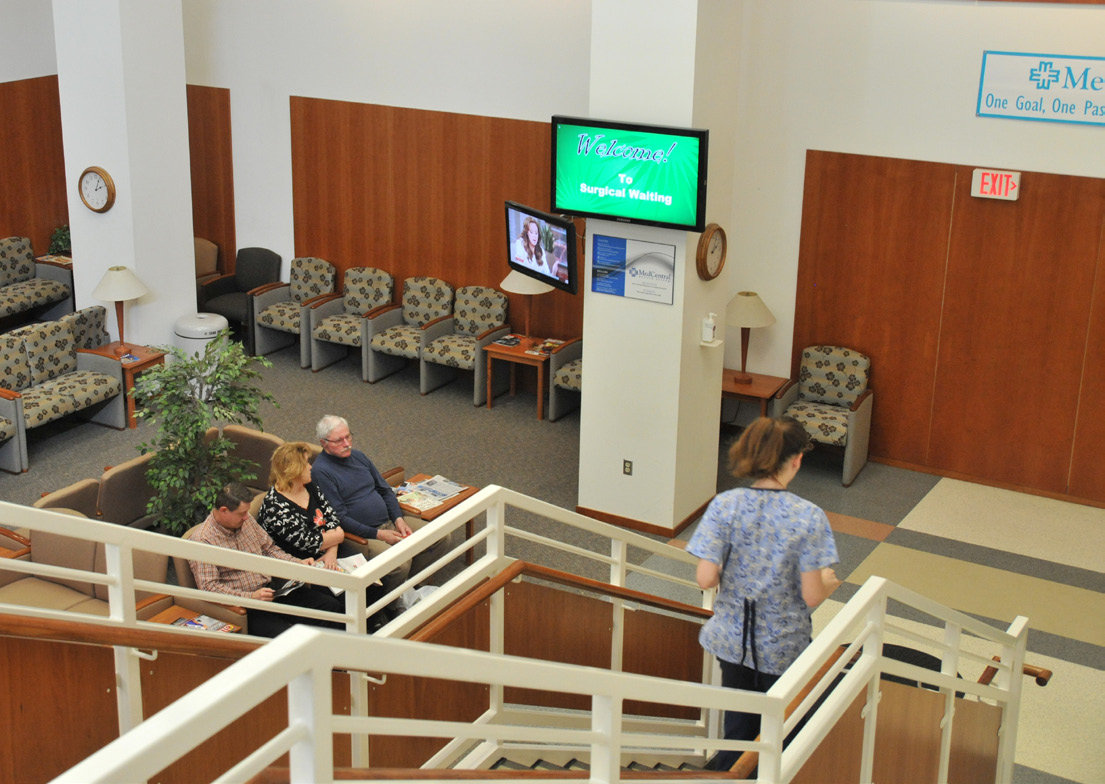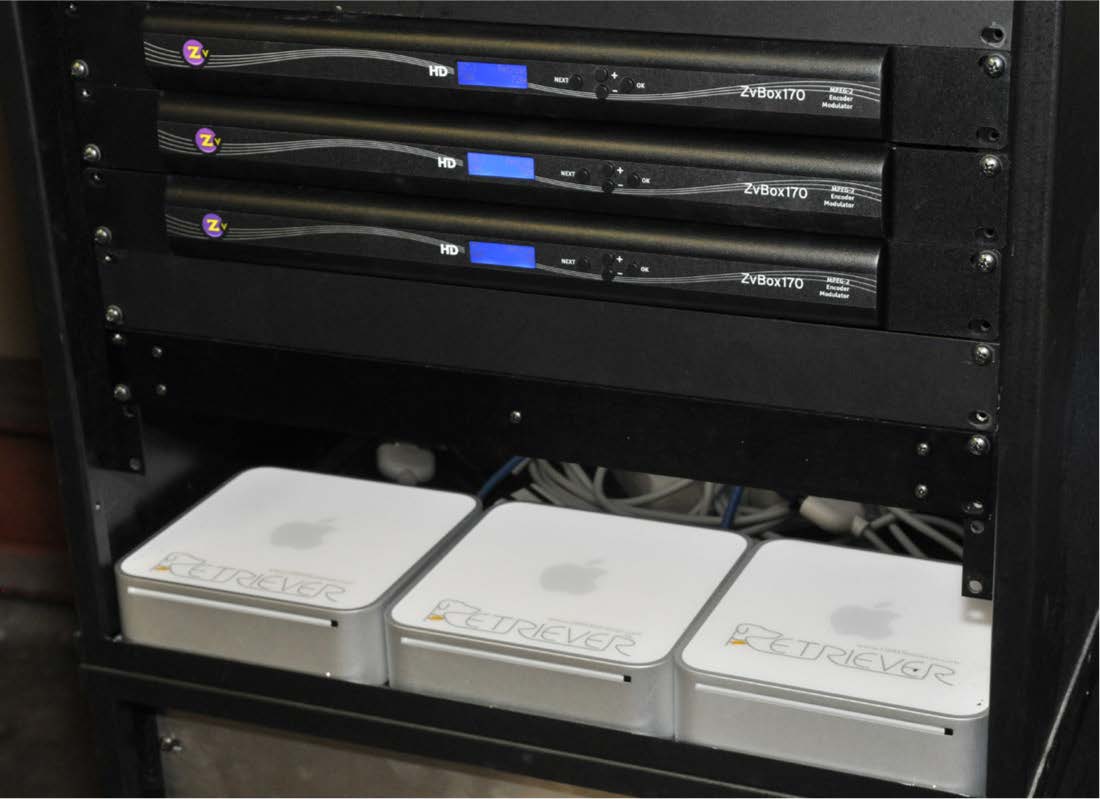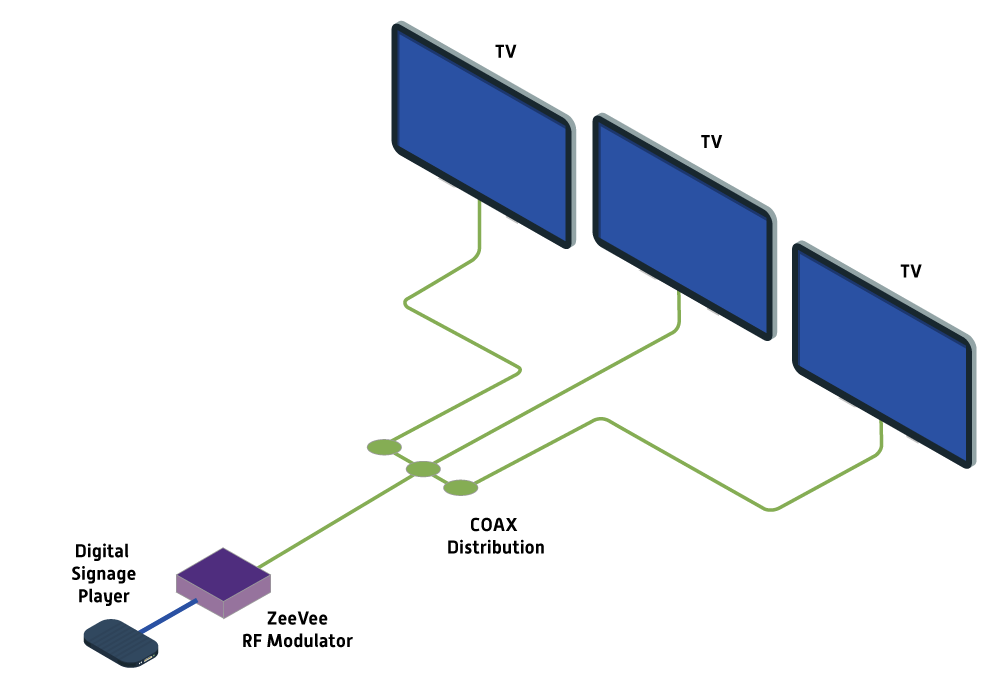Challenge
Like many medical facilities, MedCentral Health System in Mansfield, Ohio, works hard to stay connected to staff, patients, and their families. It is an organization employing 2,000 people in three facilities in two cities. The main hospital spans multiple floors, with surgery, emergency and treatment rooms spread throughout covering hundreds of thousands of square feet.
Trying to establish and maintain communication with a diverse audience of medical professionals and the general public is further complicated by the stress visitors may be experiencing. Add to that the layers of the structural renovation of the buildings over many decades and you simply cannot and a more difficult challenge.
The problem is all too common throughout the nation’s medical community. It clearly is a difficult task but worth doing considering the volume of people served and the importance of the institution. e question is how to tackle this job with limited dollars while maximizing the effect.
At MedCentral, Cindy Jakubick, Corporate Director of Public Relations and Marketing chose digital signage as one of her lines of communication. “We had and will continue to use the traditional lines of communication but it just wasn’t enough,” she said. “I began to see digital signage pop up throughout the community and was interested how we might be able to use it.”
Making the Decision
The first challenge Ms. Jakubick faced was educating the rest of the management team in the possibilities of this new form of communication. “It took time but as others saw digital signage they began to understand it,” said Jakubick. Reading about digital signage or even seeing a demonstration of a system is different from personally interacting with it in your daily activity.
Like most hospital public relations offices, MedCentral had a relationship with a media company. As it turned out, this company, DRM Productions, had been working in digital signage for a number of years. Their solution for digital signage was a system they had developed called Retriever Digital Signage. Using the Internet, the Retriever automatically updates or retrieves its content about every ten minutes.
“I’m glad I had DRM to turn to, and it helped that they had signage already in the community. The staff also trusted DRM’s professional approach on media projects after many years of working together,” said Ms. Jakubick. Being able to see Retriever Digital signage at the library, the dry cleaner, hair salon, restaurants, and even several local universities helped management understand the potential.
When choosing a digital signage system, weighing all the possibilities can be difficult. The selection process is much like comparing apples to oranges, there are similarities but also significant differences. Finding the right system for your individual needs lies at the heart of the decision. In the judgment of the staff at MedCentral, the Retriever offered all the possibilities of other systems with the right mix of features that made it easy to use, easy to install and had the eye appeal necessary to do the job. The Retriever is happily the orange in the apples-to-apples digital signage equation.
Pricing the System
In pricing a new system, many times there is a white-knuckle reaction waiting for the final cost. Cindy Jakubick was concerned about this aspect, but as it turned out, fear of the unknown was far less threatening once all the information was gathered. When given the price to install Retrievers in both MedCentral hospitals in two cities and at a health and fitness center, “[t]he expense was lower than traditional media to do the same job, so price really became a non-issue,” in Jakubick’s evaluation.
DRM Productions was able to place 5 systems in three locations that displayed different content for a price well under budget. This cost included signal distribution from a trusted DRM supplier, ZeeVee, has developed products to share HD video sources over existing coax. This solution dramatically cut costs and moved distribution from a possibility to a reality.
In other hospital applications in several other Ohio towns, the Retriever and the ZeeVee products had been successfully used to conquer similar challenges. DRM’s systematic approach to challenges along with their development of and search for products to answer a communication need where seen as the right mix of IT know-how and production professionalism.
Deploying the Signal
“Taking the signal to all the rooms as well as monitors strategically located throughout our buildings was very important,” said Jakubick. She saw the potential to educate and inform the audience to services the hospital offered which enhance the medical experience.
Because of the many additions and years of splitting coax signals, the project demanded a unique solution. Placing a signal trap at the head end of the hospital’s current cable feed and using ZeeVee’s easily tunable ZvBox 170, made the system work perfectly. is the model from ZeeVee along with two other models, the ZvPro 250 and ZvPro 280, offer HD signal distribution over coax cable for commercial applications.
The distribution system employed by the ZeeVee system entails converting the digital signage signal to an HD channel for use on the existing coax system. The ZvBox 170 analyzed the hospital’s system and gave options for inserting the signal. With pinpoint accuracy, the delivered signal was of the highest quality. The ZeeVee system allows each installation to be unique and fit the technical demands of each building’s system.
Doug McQuillen, a Biomedical Technician, and resident AV technician found the ZeeVee and the Retriever combination “[e]asier to install than I expected, and it gives me portability. I can move screens to different locations as we continually renovate. It becomes a plug and play system.”

"I began to see digital signage pop up throughout the community and was interested how we might be able to use it.”
Cindy Jakubick, Corporate Director of Public Relations and Marketing, MedCentral.
The ZeeVee system allows each installation to be unique and fit the technical demands of each building’s system.
"The expense was lower than traditional media to do the same job, so price really became a non-issue.”
Cindy Jakubick, Corporate Director of Public Relations and Marketing, MedCentral.
"Easier to install than I expected, and it gives me portability. I can move screens to different locations as we continually renovate. It becomes a plug and play system.”
Doug McQuillen, Biomedical Technician, MedCentral.
Using the Retriever

Digital signage is only as good as it is easy to update and eye-catching to the viewer. “I get positive comments from staff and the public alike,” said Jakubick. In the cafeteria, she highlights employees and has the opportunity to cross-sell services to the public.
Surgical waiting has different content that is tailored to that audience. Finally, every room gets information from the Retriever when the set is turned on, again thanks to the ZeeVee and its ability to send HD video signals over existing coax.
The system is also used at a sister hospital in another town with content designed to meet their needs. The same is true for the large fitness center owned by MedCentral. All signs can share content when directed by the system administrator. Local content for each location is currently centrally managed by the Public Relations office.
The Retriever system is trainable to allow for future local content creators anywhere within MedCentral’s system. e system administrator can also assign a specific number of slides that each location can create while maintaining central administrative control. The system is capable of expanding with user desires to answer future signage requirements.
In addition, the hospital liked the idea that all Retrievers would always have the latest operating software and features as the developers continue to evolve the system. This is possible since receiving continuing updates is automatically incorporated into every Retriever’s design.
All content can be created and monitored from any computer with Internet access. With user-friendly menus, individuals can quickly change, add or program new digital signs for immediate use or create schedules and signs for a future time. Using a series of drop-down menus, operators at the hospital select a screen-type from the numerous options. They then select a background type and color, input graphics, pictures and text and publish their creation to the system.
“It is easy to train new employees to use the Retriever; it takes about 10 minutes,” according to Jakubick. Many claim that their system is easy to use. In the mind of DRM, the proof is in the doing. The Retriever is so easy to use that DRM has put the system onto the Retriever website for anyone to try. Many times, usability for digital signage is the make or break component in its effectiveness.
DRM Productions programmed their system to anticipate user need. is allows the Retriever to be simple to use and yet maintain a wide array of choices that keeps the final screen image at a professional level with animated backgrounds and specialty screens. e ability to use RSS feeds and weather content to automatically update the sign is also a welcomed feature for the user and the public.
The Retriever Digital Signage system conquered space and structural challenges. The system delivers a timely product below the cost of traditional media. The Retriever is user and viewer friendly. According to Cindy Jakubick at MedCental Health Systems, “I now have a new communication tool that works great and is very effective. It’s a whole new way of communicating.”


